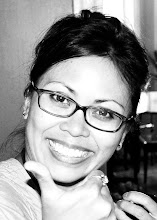Ding is currently a first year graduate student at George Washington University. Before that she was the Program Director of the Washington Project for the Arts Corcoran (now Washington Project for the Arts). She grew up in Maryland and received her undergraduate degree at University of Maryland, Baltimore County. Ding currently is a Fine Arts Fellow & Graduate Teaching Assistant at GW. She helps run the GW photo lab every week which is where she also creates her work and where our visit took place. Ding also writes and you can see her latest work by clicking on the links at the bottom of this post.


Ding in the darkroom talking about her projects.
Ding started out as a photography major in the GW program (see photos of the Cut Out Project below) but after having critiques that were not going in the direction she wanted, she began to veer into more performance and conceptually based projects where the focus was on the process and not the final product. Still using the cut out idea, she decided to take it a step further by doing a large scale installation in the hallway of her school. She counted how many tiles were on the floor, then cut out squares and lined the hallway with these cut outs. She hung the negative section on the walls and put the positive on floor. In the end she had cut 1200 squares.


The Cut Out Project seen installed in the landscape and afterwards collected and boxed up.
The amount of time to cut out these squares created a dilemma which transitioned to her “Replacement Performance Project”. She decided to hire someone to go to her class in order that she could do all the cutting herself.
“When they came in and sat as me, I was creating squares which enabled me to complete the project. I also wanted to bring in a fresh perspective into the critiques….it was the first time in the program where I felt really comfortable with what I was doing and it was interesting how one person could change the dynamic. There were some strong responses in regards to the privilege of being able to purchase labor.” But her response is that it’s the same as purchasing art supplies. “This brought up notions of affecting boundaries and what does it mean to be in the context of an art school, a sheltered environment, so I got interested in pushing that further.”
She also started exploring what she would present as “proof” of these events other than the photograph. This led to the signed and framed contract. Everything else from the performance would exist as a dialogue and in the memory of witnessing the performance.”


The Contract, one in the frames and another that I was about to sign.
This semester Ding was presented with a number of opportunities. In order to be able to do a number of outside projects in conjunction with her graduate work, she decided to combine them in to one performance called
“The Extracurricular Project”. She had me sign a very formal and seemingly legal contract akin to one a gallery may present to a new artist who is willing to make the commitment of being with them for a given time period.
“The contract basically stipulates that you, the client has requested that I participate in a project that you’re working on and that you’re allowing me to use this interview and the final product as part of my studio practice that is considered as a piece of art work. I will frame the signed contract and put it along side the final product of the client and in your case your blog”.
“I purposely try to make it formal”.
Another example of Ding’s transition from the photograph to the performance was her “Asian Tourist” performance. She happened to be at the Jefferson Memorial working on something else last spring, when a large group of Chinese tourists approached her to take their photograph. They spoke to her in Chinese and she responded back in Chinese.


Ding in the printing room showing the photographs from The Asian Tourist Project.
This sparked her interest in engaging with the stereotype of Asian tourists taking photographs of themselves posing in front of anything and everything and often times in large groups. “I’m Asian so why don’t I make art that is perpetuating the Asian stereotype of Asians taking photos? (Ding above showing photos of these events).
I went back to the Lincoln Memorial and approached Asian tourists that were photographing themselves and asked them if I could take their photograph as a group so no one was left out of the shot…. so I was extending a kind gesture…I wanted to document the process of me taking their photo and me handing the camera back…so that moment of contact was documented. I wanted it to be an ephemeral moment.” Not everyone accepted her offer, but most people did. She hopes to do it again this spring.
 Ding in the Hallway connecting the darkroom to the printing room.
Ding in the Hallway connecting the darkroom to the printing room. “I Wish I Had Thought of That” project evolved from doing research for a critical theory course. She found herself in awe of mainly conceptual artists and literally thinking to herself: “I wish I had thought of that”. Ding recreated pieces by Stefan Bruggemann: the ‘nothing boxes’; Yuken Teruya: taking designer shopping bags and cutting out an intricate tree into it, and Martin Creed: blowing up balloons (and in the end popping them one by one--see her website for the real time popping) and placing them all in one spot.


 The popped balloons and now installed in a corner of her darkroom.
The popped balloons and now installed in a corner of her darkroom.This month Ding has two pieces of writing published:one can be read online here:
http://www.urbanitebaltimore.com/sub.cfm?issueID=58§ionID=4&articleID=891
and is also in the print version of Urbanite March issue. Urbanite isan arts & culture magazine based in Baltimore.Another is an essay on the constraints of language and experience for Locus 4 (an arts publication that her friends from UMBC started)http://locusartmagazine.org/
You can't read this online, but she’s about to post it on her website at www.dingren.net where you can also contact her directly.
.jpg)






No comments:
Post a Comment